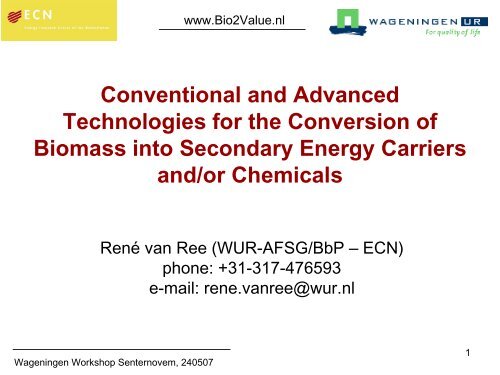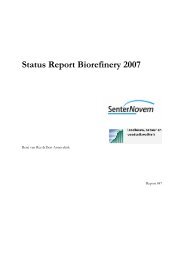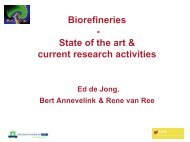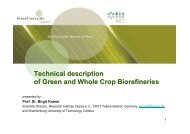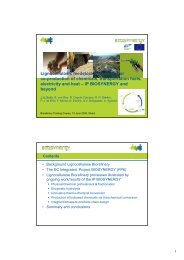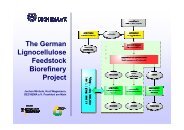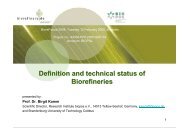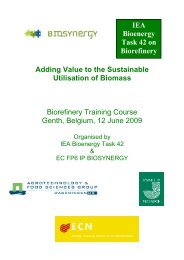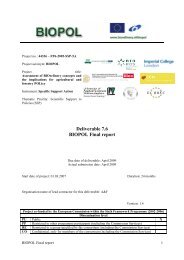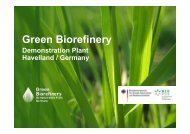Conventional and Advanced Technologies for the ... - Biorefinery
Conventional and Advanced Technologies for the ... - Biorefinery
Conventional and Advanced Technologies for the ... - Biorefinery
Create successful ePaper yourself
Turn your PDF publications into a flip-book with our unique Google optimized e-Paper software.
www.Bio2Value.nl<br />
<strong>Conventional</strong> <strong>and</strong> <strong>Advanced</strong><br />
<strong>Technologies</strong> <strong>for</strong> <strong>the</strong> Conversion of<br />
Biomass into Secondary Energy Carriers<br />
<strong>and</strong>/or Chemicals<br />
René van Ree (WUR-AFSG/BbP – ECN)<br />
phone: +31-317-476593<br />
e-mail: rene.vanree@wur.nl<br />
Wageningen Workshop Senternovem, 240507<br />
1
www.Bio2Value.nl<br />
Content<br />
1. National policy goals within a European framework<br />
2. Vision LT (2030) use biomass in <strong>the</strong> Dutch economy (PGG)<br />
3. LT Raw material requirements<br />
4. Current use of biomass within <strong>the</strong> Dutch (energy) infrastructure<br />
5. <strong>Conventional</strong> biomass conversion technologies (selection)<br />
6. <strong>Advanced</strong> biomass conversion technologies (selection)<br />
7. Technology <strong>and</strong> product transition pathways<br />
8. Costs products <strong>and</strong> CO 2 -emission reduction potential<br />
9. Optimal biomass conversion strategy to meet future market<br />
requirements – <strong>Biorefinery</strong><br />
10. Discussion - Conclusions<br />
Wageningen Workshop Senternovem, 240507<br />
2
www.Bio2Value.nl<br />
1. National policy goals within a European framework<br />
• 5% renewable energy in 2010 (10% in 2020)<br />
about 80% is expected to be bio-based<br />
• EU-objectives: 2 <strong>and</strong> 5.75% biofuels in transportation<br />
sector in 2005 <strong>and</strong> 2010 (achieved in 2005: about 1%)<br />
• EU Energy Package (10-01-07):<br />
- 20% ghg reduction in 2020 compared to 1990 (energy efficiency,<br />
nuclear, CO 2 -capture/disposal, renewables)<br />
1. EC-proposal: 20% renewable energy in 2020<br />
2. EC-proposal: 10% biofuels <strong>for</strong> transport in 2020 (binding target)<br />
Wageningen Workshop Senternovem, 240507<br />
3
www.Bio2Value.nl<br />
2. LT Vision - use biomass in <strong>the</strong> Dutch economy (PGG 1 )<br />
30% fossil-based raw materials <strong>and</strong> fuels substitution in <strong>the</strong><br />
Dutch economy in 2030<br />
Application<br />
Biofuels <strong>for</strong><br />
transport<br />
Chemicals,<br />
materials<br />
Power<br />
FF substitution<br />
[%]<br />
[PJ th, affu ]<br />
CO 2 -em.red.<br />
[Mt/a]<br />
60 (very ambitious) 324 24<br />
25 (R&D >) 140 11<br />
25 (full plant<br />
substitution necessary)<br />
203 14<br />
Heat 17 (mainly SNG) 185 10<br />
1<br />
PGG: Plat<strong>for</strong>m Bio-based Raw Materials; between () are comments ECN/WUR<br />
Wageningen Workshop Senternovem, 240507<br />
4
www.Bio2Value.nl<br />
3. LT raw material requirements (1)<br />
Assumption:<br />
total energy dem<strong>and</strong> Dutch economy in 2030:<br />
3000 PJ th (strong energy savings required) [PGG, 2006]<br />
30% fossil fuel <strong>and</strong> raw material substitution in 2030<br />
corresponds to about 850 PJ th [PGG, 2006]<br />
2030 raw biomass requirement to meet dem<strong>and</strong>s in<br />
different market sectors: about 1200 PJ th or about<br />
80 million tonnes (d.b.)<br />
Wageningen Workshop Senternovem, 240507<br />
5
www.Bio2Value.nl<br />
3. LT raw material requirements (2)<br />
Gross national biomass production ((import-export) +<br />
production) in 2000: 42.3 Mtonnes (about 742 PJ th )<br />
only a small part is available <strong>for</strong> non-food applications !<br />
Projection national biomass availability <strong>for</strong> non-food<br />
applications in 2030:<br />
• 6 Mt d.b. primary by-products (100 PJ th<br />
)<br />
• 12 Mt d.b. secondary by-products (200 PJ th<br />
)<br />
• 0 - 9 Mt d.b. energy crops (0 -150 PJ th<br />
) (uncertain, multi-functional crops)<br />
Total: 18 - 27 Mt d.b. or 300 - 450 PJ th<br />
60 - 80% of <strong>the</strong> required biomass has to be imported !!!<br />
Wageningen Workshop Senternovem, 240507<br />
6
www.Bio2Value.nl<br />
4. Current use of biomass within <strong>the</strong> Dutch (energy)<br />
infrastructure [PJ th, affu ]<br />
Direct/indirect cofiring<br />
Estimation <strong>for</strong> 2005 1<br />
29<br />
Maximally achievable in<br />
2010 2<br />
56<br />
Domestic waste comb.<br />
L<strong>and</strong>fill gas<br />
CHP – digestion<br />
CHP comb./gasification<br />
Biofuels <strong>for</strong> transport<br />
Total<br />
11.5<br />
1.6<br />
4-6<br />
11.7<br />
< 2<br />
about 60 (=1.8% total)<br />
18<br />
1<br />
5<br />
17<br />
23 (5.75%)<br />
120 (3-4% total)<br />
1<br />
Statusdocument Bioenergie 2005, SenterNovem, 161105; 2 Ecofys DEN-project 2004<br />
Wageningen Workshop Senternovem, 240507<br />
7
www.Bio2Value.nl<br />
5. <strong>Conventional</strong> biomass conversion technologies<br />
5.1 Co-firing in coal-fired power plants<br />
Direct cofiring: conversion pre-treated biomass through existing coal train<br />
(+) low specific investment costs (100 €/kWe)<br />
(+) high biomass conversion efficiency to power (39-40 %LHV)<br />
(-) not applicable <strong>for</strong> all biomass materials because of potential contamination<br />
coal-ash, slagging/fouling/corrosion problems, emission constraints<br />
Indirect cofiring: conversion biomass in an upstream unit (gasification, pyrolysis,<br />
combustion) <strong>and</strong> integration (gas, oil, steam) with <strong>the</strong> coal plant<br />
(-) higher specific investment costs (500-1250 €/kWe)<br />
(-) lower biomass conversion efficiency to power (35-38 %LHV)<br />
(+) applicable <strong>for</strong> more biomass materials because of<br />
pre-separation potential contaminants<br />
Expensive clean biomass -> direct cofiring (rel. cheap, high eff.)<br />
Cheap contaminated biomass -> indir. cofiring (rel. exp., lower eff.) -> power prod.<br />
Wageningen Workshop Senternovem, 240507<br />
8
www.Bio2Value.nl<br />
5. <strong>Conventional</strong> biomass conversion technologies<br />
5.1 Co-firing example (1) – direct cofiring<br />
In all 8 Dutch power plants 5 – 10% biomass is co-fired directly.<br />
1000 MW th biomass input (31.5 PJ th d.b. ) requires about 1.5 Mt d.b./a<br />
Hemweg power plant of NUON<br />
630 MWe (net) pulverised coal<br />
fired<br />
Gelderl<strong>and</strong> power plant of<br />
Electrabel<br />
602 MWe (net) pulverised coal<br />
fired ST: 180 bar, 540°C -><br />
0.04 bar, 30°C<br />
Amer power plant of Essent<br />
1245 MWe (net) <strong>and</strong> 600 MWth<br />
pulverised coal fired<br />
2 CHP units AMER-8 <strong>and</strong> AMER-9<br />
Wageningen Workshop Senternovem, 240507<br />
9
www.Bio2Value.nl<br />
5. <strong>Conventional</strong> biomass conversion technologies<br />
5.1 Co-firing example (2) (Amer-9 Essent)<br />
Indirect cofiring of 150<br />
kt/a demolition wood<br />
Efficiencÿ: about<br />
38%LHV<br />
Wageningen Workshop Senternovem, 240507<br />
10
www.Bio2Value.nl<br />
5. <strong>Conventional</strong> biomass conversion technologies<br />
5.2 Domestic waste combustion example (AEB A’dam)<br />
Waste combustion was volume reduction<br />
Now more <strong>and</strong> more modification to “highefficient”<br />
(eff. > 30 %LHV) AVIs<br />
Wageningen Workshop Senternovem, 240507<br />
11
www.Bio2Value.nl<br />
5. <strong>Conventional</strong> biomass conversion technologies<br />
5.3 Thermal processes <strong>for</strong> power, heat, CHP production<br />
Combustion processes<br />
- Grate combustion: (+) low investment costs; (-) low efficiency<br />
- Fluidised bed combustion: (+) low investment at high capacity (> 10 MWth), T=c<br />
Pyrolysis processes<br />
- Slow conventional pyrolysis: t = 10 min – hours; heating: 0.1-100°C/s at LT -> mainly char<br />
- Fast/flash pyrolysis: t = 0.1 – 5 sec; heating: several 100°C/s at MT -> mainly bio-oil<br />
Gasification processes<br />
- Fixed bed gasifiers:<br />
- Fluidised bed gasifiers<br />
- Entrained-flow gasifiers<br />
Air-blown<br />
Steam/oxygen-blown<br />
Indirect<br />
Atmospheric<br />
Pressurised<br />
Atmospheric LT air-blown FB-gasifiers -> fuel / product gas -> CHP production<br />
Pressurised HT oxygen-blown EF/FB-gasifiers -> syngas -> Syn<strong>the</strong>sis processes<br />
Atmospheric LT air-blown indirect gasifiers -> syngas -> Syn<strong>the</strong>sis processes<br />
Wageningen Workshop Senternovem, 240507<br />
12
www.Bio2Value.nl<br />
5. <strong>Conventional</strong> biomass conversion technologies<br />
5.4 St<strong>and</strong>-alone combustion example (Lelystad, NUON)<br />
Input: 7.5 MW th<br />
Technology: grate firing<br />
Output: 0.7 MW e ; availability installation: 7500 hour/year; electrical eff.: 8 %LHV;<br />
<strong>the</strong>rmal eff.: 69 %LHV<br />
Specific investment costs: 16000 €/kW e ; Technology: commercial available<br />
Wageningen Workshop Senternovem, 240507<br />
Source: SenterNovem 2DEN-04.12<br />
13
www.Bio2Value.nl<br />
5. <strong>Conventional</strong> biomass conversion technologies<br />
5.4 St<strong>and</strong>-alone combustion example (Cuijk, Essent)<br />
Input: 270 kton wood chips (50% moisture) = about 85 MW th a year. Availability: 7600<br />
hours/year. Technology: BFB combustion.<br />
Output: 25 MW e -> 190 GWh e /year. Electrical efficiency: 30 %LHV.<br />
Specific investment costs: 1820 €/kW e ; Technology: commercial available<br />
Wageningen Workshop Senternovem, 240507<br />
14
www.Bio2Value.nl<br />
5. <strong>Conventional</strong> biomass conversion technologies<br />
5.5 Air-blown atm. gasification <strong>for</strong> power/CHP production<br />
(example HoSt)<br />
Sungas-installation in Galati, Romania<br />
Wageningen Workshop Senternovem, 240507<br />
Chicken manure gasification in<br />
Friesl<strong>and</strong> (Tzum)<br />
15
www.Bio2Value.nl<br />
5. <strong>Conventional</strong> biomass conversion technologies<br />
5.6 Digestion <strong>for</strong> power/CHP production, example OWF<br />
digestion of Vagron in Groningen<br />
Installation:<br />
Input:92 kton OWF from 168<br />
kton domestic waste a year.<br />
Output:8.5 MMNm 3 biogas<br />
(about 55% CH 4<br />
) a year -> 4<br />
* 630 kW e<br />
= about 2.5 MW e<br />
-> 14.3 GWh e<br />
Specific investment costs:<br />
7800 €/kW e<br />
.<br />
Wageningen Workshop Senternovem, 240507<br />
16
www.Bio2Value.nl<br />
5. <strong>Conventional</strong> biomass conversion technologies<br />
5.7 Biodiesel production<br />
Oil-rich<br />
crops<br />
Pretreatment<br />
Pressing<br />
Fossil<br />
Methanol<br />
Waste<br />
vegetable<br />
oils,<br />
animal<br />
fats<br />
Cake<br />
(feed)<br />
Pretreatment<br />
Transesterification<br />
Glycerol<br />
Biodiesel<br />
(FAME)<br />
Dutch market inititiatives:<br />
- Biofuelling (ES)/Zeel<strong>and</strong> Seaports (2008): 200 -<br />
600 kt/a<br />
- BioPetrol (SUI)/R’dam (2007): 400 kt/a<br />
- Biovalue (Eemshaven): status unclear<br />
- Sunoil Emmen (2006): 30 kt/a<br />
- Ten Kate Ter Apelkanaal (2007): 10 Ml/a from fats<br />
Wageningen Workshop Senternovem, 240507<br />
Developments:<br />
- Former Methanor: biodiesel-derived glycerol<br />
-> biomethanol -> transesterification<br />
-> 100% green biodiesel<br />
- Use of ethanol instead of methanol<br />
17
www.Bio2Value.nl<br />
5. <strong>Conventional</strong> biomass conversion technologies<br />
Sugars:<br />
cane<br />
beets<br />
sorghum<br />
molasse<br />
Starch:<br />
wheat<br />
mais<br />
patatoes<br />
agro-residues<br />
5.8 <strong>Conventional</strong> bioethanol production<br />
Enzyme<br />
Liquefaction <strong>and</strong><br />
hydrolysis<br />
Yeast<br />
Water<br />
Fermentation<br />
<strong>and</strong> distillation<br />
Co-products<br />
Bioethanol<br />
Production costs (2005):<br />
15 Brazil) – 55 (Germany) €ct/l<br />
Dutch market inititiatives (selection):<br />
- Nedalco Sas van Gent/Cerestar (2008): 220<br />
Ml/a (400 kt/a) based on organic residues,<br />
integration 2 0 -generation technology<br />
- BER/HES Beheer Rotterdam (2007): 100kt/a<br />
- Lyondel Botlek: 600 kt/a ETBE<br />
- Harvest Biofuels A’dam (2007): 110 kt/a<br />
- Sabic Geleen: 140 kt/a ETBE<br />
- Argos Oil R’dam:Argos e-fuel (5% eth.)<br />
Wageningen Workshop Senternovem, 240507<br />
Developments:<br />
- Use of more difficult raw materials<br />
- Pathway to lignocellulosic bioethanol<br />
18
www.Bio2Value.nl<br />
6. <strong>Advanced</strong> biomass conversion technologies<br />
6.1 Oxygen-blow press. IGCCs <strong>for</strong> power/CHP production<br />
NUON Buggenum coal/biomass<br />
fired plant (NL): 250 MW e<br />
Elcogas Puertollano plant (ES): 320 MW e<br />
Large-scale high-efficiency<br />
(45- 50 %(LHV)<br />
BIG/CC-technology<br />
Wageningen Workshop Senternovem, 240507<br />
Potential Dutch initiatives<br />
MAGNUM (NUON),<br />
2 0 -Maasvlake<br />
19
www.Bio2Value.nl<br />
6. <strong>Advanced</strong> biomass conversion technologies<br />
6.2 Air-blown indirect gasification <strong>for</strong> SNG production<br />
Transport losses powert (4%) versus<br />
green gas (1%)<br />
2003: World’s first “green gas” production at labscale<br />
(ECN)<br />
Currently basic-design pilot installation at ECN<br />
(“Milena”)<br />
cheap production<br />
at large scale<br />
biomass import<br />
no local biomass<br />
transport<br />
CO 2 available <strong>for</strong><br />
storage, EOR, ...<br />
gas storage enables<br />
whole year operation<br />
SNG<br />
plant<br />
efficient <strong>and</strong> cheap<br />
distribution of gas<br />
existing<br />
gas grid<br />
natural gas<br />
back-up<br />
easy<br />
application<br />
Discussions about demo-installation (R’dam,<br />
Energy Valley, …)<br />
easy to meet<br />
emission limits<br />
distributed use <strong>for</strong><br />
transport, heat,<br />
electricity<br />
high social<br />
acceptance<br />
Wageningen Workshop Senternovem, 240507<br />
biomass<br />
SNG (Substitute Natural Gas)<br />
20
www.Bio2Value.nl<br />
6. <strong>Advanced</strong> biomass conversion technologies<br />
6.3 Biomass-to-Liquids (BtL) (1)<br />
Reference GtL:<br />
Demonstration plant<br />
Bintulu,Malaysia<br />
Capacity:<br />
- 14,000 bbl/day<br />
- 28 PJ fuel product<br />
- 1400 MWth BioSyngas<br />
Equivalent to:<br />
- 1,700 MWth raw biomass<br />
Full-scale SMDS in Quatar<br />
- 75,000 bbl/day<br />
- about 10,000 MWth biomass<br />
Wageningen Workshop Senternovem, 240507<br />
21
www.Bio2Value.nl<br />
6. <strong>Advanced</strong> biomass conversion technologies<br />
6.3 Biomass-to-Liquids (BtL) (2)<br />
Yield from tree-to-barrel<br />
electricity<br />
from off-gas<br />
light<br />
FT product<br />
wood<br />
(Biomass)<br />
1 ton<br />
wood<br />
Gasification<br />
biosyngas<br />
Fischer-Tropsch<br />
Syn<strong>the</strong>sis<br />
~260 L<br />
FT wax<br />
~210 L<br />
green diesel<br />
Energy efficiency from wood to diesel = ~44%, light products: 11%, power: 14% -><br />
total energetic efficiency: 69%<br />
Wageningen Workshop Senternovem, 240507<br />
Optimised technology; 7% moisture; 78% CGE to<br />
syngas; 95% FT conversion; 92% C5+ yield; 80% waxto-diesel<br />
yield; EE to light product 11%; EE to electricity 22<br />
14% (55% CC, 25% heat); overall EE 69%
www.Bio2Value.nl<br />
45<br />
6. <strong>Advanced</strong> biomass conversion technologies<br />
6.3 Biomass-to-Liquids (BtL) (3)<br />
Production costs [€/GJ_FT-liq]<br />
40<br />
35<br />
30<br />
25<br />
20<br />
15<br />
10<br />
5<br />
0<br />
10 100 1,000 10,000<br />
Plant capacity [MW th biomass input]<br />
For reference: 15 €/GJ = 55 €ct/L<br />
Wageningen Workshop Senternovem, 240507<br />
Conversion<br />
Pre-treatment<br />
Transport<br />
Biomass<br />
Scale factor = 0.5 <strong>for</strong> scale<br />
< 2,500 MW th<br />
, results in:<br />
- 100 €/GJ FT<br />
at 10 MW th<br />
-40 €/GJ FT<br />
at 100 MW th<br />
-20 €/GJ FT<br />
at 1,000 MW th<br />
• Biomass costs = 4 €/GJ_ar<br />
• Pre-treatment costs = 1.5 €/GJ_ptt_bm<br />
• Local biomass (truck transport)<br />
• Variable transport costs: 0.08 €/ton/km<br />
• Deprecation = 10 years (linear)<br />
• Required IRR = 12%<br />
• O&M costs: 7%<br />
• Scale factor = 0.7 (whole range)<br />
• Availability = 8,000 h/y<br />
• Pre-treatment efficiency<br />
(torrefaction) = 97%<br />
• Gasification efficiency<br />
(biomass to biosyngas) = 80%<br />
• Conversion efficiency<br />
(biosyngas to FT C 5 + liquids) = 71%<br />
23
www.Bio2Value.nl<br />
6. <strong>Advanced</strong> biomass conversion technologies<br />
6.4 Depolymerisation/hydrolysis/fermentation (1)<br />
Example of<br />
lignocellulosic BM:<br />
Wheat straw<br />
Composition [wt% ar]<br />
Cellulose: 24.8<br />
Hemicellulose: 24.4<br />
Lignin: 25.2<br />
O<strong>the</strong>r organics: 8.0<br />
Ash: 6.7<br />
Moisture: 10.9<br />
Cellulose,<br />
Hemicellulose,<br />
Lignin<br />
Lignocellulosic BM<br />
Enzymes<br />
Enzymatic<br />
hydrolysis<br />
Lignin<br />
C6 & C5<br />
sugars<br />
Nedalco<br />
patent<br />
<strong>Advanced</strong><br />
Fermentation<br />
Physical &<br />
chemical<br />
pretreatment<br />
CHP<br />
production<br />
Destillation<br />
<strong>and</strong><br />
dehydratation<br />
Critical R&D-issues:<br />
- Physical/chemical pretreatment<br />
- Enzymatic hydrolysis<br />
- Co-fermentation C6/C5 sugars<br />
- Process integration (heat, water, …)<br />
Wageningen Workshop Senternovem, 240507<br />
- Heat <strong>for</strong> processes<br />
- Power <strong>for</strong><br />
processes <strong>and</strong> grid<br />
- Minerals <strong>for</strong><br />
buiilding materials,<br />
fertilizers<br />
Cellulosic<br />
ethanol<br />
99.7 vol%<br />
24
www.Bio2Value.nl<br />
6. <strong>Advanced</strong> biomass conversion technologies<br />
6.4 Depolymerisation/hydrolysis/fermentation (2)<br />
Physical/chemical pre-treatment of raw biomass<br />
Wageningen Workshop Senternovem, 240507<br />
25
www.Bio2Value.nl<br />
6. <strong>Advanced</strong> biomass conversion technologies<br />
6.4 Depolymerisation/hydrolysis/fermentation (3)<br />
Basic Design 190 Ml/yr 99.7vol% ethanol from wheat straw<br />
Energy balance Net out: ethanol (139 MW th ) <strong>and</strong> power (25<br />
MW e ) / raw materials in (380 MW th ) = 43 %(LHV)<br />
Total Capital Investment: about 320 M€<br />
about: 50% <strong>for</strong> CHP-unit <strong>and</strong> 10% <strong>for</strong> pretreatment<br />
Straw: 38.5 €/t d.b.<br />
2.5 €/GJ a.r.<br />
Ethanol production costs:<br />
- about 0.52 €/litre<br />
- minimum selling price: 0.75 €/l<br />
(IRR: 15%)<br />
Wageningen Workshop Senternovem, 240507<br />
Capital charge<br />
33%<br />
O<strong>the</strong>r<br />
10%<br />
Labour costs<br />
2%<br />
Maintenance<br />
15%<br />
Straw<br />
25%<br />
Glucose<br />
(Enzymes)<br />
10%<br />
Water treatment<br />
1%<br />
Chemicals<br />
4%<br />
26
www.Bio2Value.nl<br />
7. Technology <strong>and</strong> product transition pathways<br />
7.1 Fossil diesel substitution (example)<br />
“<strong>Conventional</strong>”<br />
biofuels<br />
<strong>Advanced</strong> biofuels<br />
Ethanol <br />
Biomassto-Liquids<br />
Lignocellulosic<br />
biomass<br />
Large volumes<br />
Rel. low price<br />
No competition<br />
food/feed<br />
Next biodiesel<br />
<strong>Conventional</strong> biodiesel<br />
Glycerol-tomethanol<br />
H 2<br />
(NesteOil)<br />
Coal-to-<br />
Liquids<br />
Pure plant oil (PPO)<br />
Oil-rich crops<br />
Wageningen Workshop Senternovem, 240507<br />
Fats <strong>and</strong><br />
waste oils<br />
Coalfired<br />
IGCC<br />
Gas-to-<br />
Liquids<br />
27
www.Bio2Value.nl<br />
7. Technology <strong>and</strong> product transition pathways<br />
7.2 Fossil gasoline substitution (example)<br />
“<strong>Conventional</strong>”<br />
biofuel<br />
<strong>Advanced</strong> biofuels<br />
Lignocellulosic ethanol<br />
Modified ethanol<br />
<strong>Conventional</strong> ethanol<br />
Sugar/starch crops<br />
Wageningen Workshop Senternovem, 240507<br />
Agro-residues<br />
Lignocellulosic<br />
biomass<br />
Large volumes<br />
Rel. low price<br />
No competition<br />
food/feed<br />
Syn<strong>the</strong>tic<br />
lignocellulosic<br />
alcohols<br />
Coal-fired<br />
IGCC<br />
BIG -<br />
syn<strong>the</strong>sis<br />
28
Wageningen Workshop Senternovem, 240507<br />
www.Bio2Value.nl<br />
10. Discussion - Conclusions<br />
It is expected that biomass <strong>and</strong> biomass-derived intermediates will play a<br />
predominating role in <strong>the</strong> transition to – <strong>and</strong> <strong>the</strong> realisation of – a more sustainable<br />
Dutch ecomomy.<br />
Biomass will be applied in almost all economic sectors.<br />
Because of contractability <strong>and</strong> financial economic issues it is expected that biomass<br />
will be applied on <strong>the</strong> longer-term preferably <strong>for</strong>: food, feed, materials, chemicals,<br />
transportation fuels, gaseous energy carriers, power <strong>and</strong> finally heat.<br />
The domestic available biomass in <strong>the</strong> Ne<strong>the</strong>rl<strong>and</strong>s – i.e. agrocultural residues,<br />
wood residues, <strong>for</strong>est residues, … <strong>and</strong> specific grown crops – will not be enough to<br />
meet <strong>the</strong> longer term market dem<strong>and</strong>.<br />
Large-scale import of relatively expensive biomass, biomass-related intermediates<br />
(or final products) require high-efficient conversion processes <strong>for</strong> profitable<br />
business.<br />
<strong>Biorefinery</strong> processes are expected to become major players in <strong>the</strong> future Bio-based<br />
Economy (high-efficiency, low environmental impact).<br />
29
www.Bio2Value.nl<br />
For <strong>the</strong> full presentation (34 slides)<br />
www.biorefinery.nl<br />
More in<strong>for</strong>mation<br />
www.ecn.nl<br />
www.biobasedproducts.nl<br />
Wageningen Workshop Senternovem, 240507<br />
30


